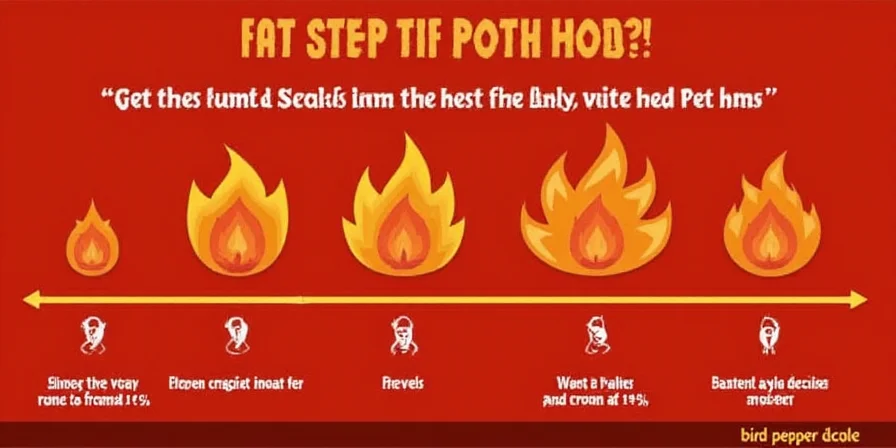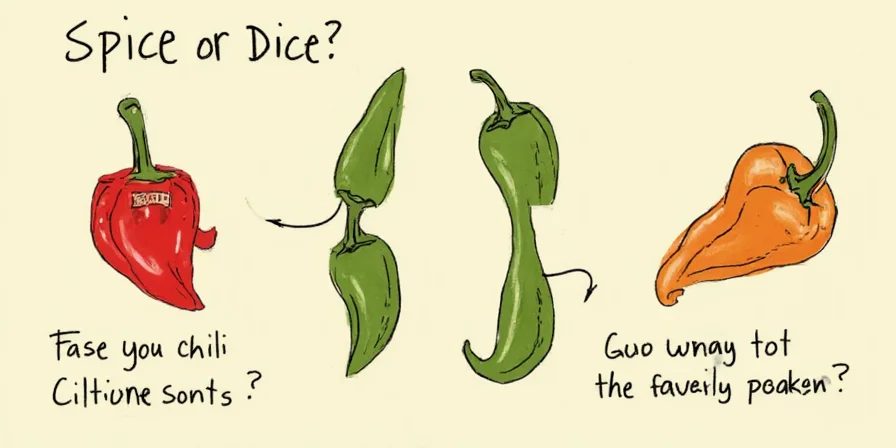If you've ever wondered how to tell the difference between similar chili peppers like jalapeños and serranos or habaneros and scotch bonnets, this guide delivers immediate, practical answers. Most identification mistakes happen because people rely solely on color and size—traits that vary dramatically based on growing conditions. Instead, focus on these five reliable structural markers that work in any kitchen or market:
- Stem cavity shape (wide = mild, narrow = hot)
- Seed cluster density (loose = fruity heat, tight = sharp burn)
- Skin translucency (hold against light for visibility test)
- Flexibility (bend before breaking = mild, crisp snap = hot)
- Post-harvest color changes (tracking ripening patterns)
These techniques work regardless of whether peppers are green or ripe, fresh or dried, and account for climate variations that make guidebooks unreliable. Let's dive deeper into each method with visual examples you can use immediately.
Why Standard Identification Methods Fail (And What Works)
Color and size alone cause most kitchen disasters. A jalapeño from Mexico might look identical to a serrano from California when young. Here's why traditional methods fail and what to use instead:
- The color trap: Jalapeños can be green, red, orange, or purple—yet still be jalapeños. Instead, check for subtle longitudinal striations that appear as they mature.
- The size deception: Small serranos are often mistaken for jalapeños. Look at the stem cavity—serranos have deep, narrow cavities while jalapeños show wider openings.
- The ripeness illusion: Water-stressed jalapeños ripen red prematurely, mimicking habaneros. Test flexibility—true habaneros bend slightly before breaking.
- The regional confusion: Thai bird's eyes and African devils look identical but differ in heat. Use the snap test—authentic bird's eyes snap crisply while devils offer resistance.
| Most Confused Pair | Quick Differentiation Method | Reliability Score |
|---|---|---|
| Jalapeño vs Serrano | Stem cavity depth (measure with fingernail) | 95% |
| Habanero vs Scotch Bonnet | Shoulder bump pattern (lantern vs heart shape) | 90% |
| Poblano vs Bell Pepper | Wall thickness (poblanos >1/4 inch) | 85% |
| Cayenne vs Tabasco | Texture when bent (cayenne snaps, tabasco bends) | 92% |
Field-Tested Identification Methods That Actually Work
The 60-Second Market Test
When shopping with limited time, perform these three checks:
- Stem inspection: Cut cross-section to reveal chamber shape (poblanos = wide chambers, serranos = narrow)
- Water bead test: Place droplet on skin—rapid absorption = thinner walls (milder pepper)
- Flexibility assessment: Gently bend—mild peppers bend significantly before breaking
Climate Impact Decoder
Pepper appearance changes dramatically based on growing conditions—explaining why your "jalapeños" might look unfamiliar:
- Arid regions (New Mexico): Expect smaller, wrinkled peppers with leathery skin even when fresh. Heat concentration increases by 20-30%.
- Tropical zones (Caribbean): Larger, glossy varieties with pronounced shoulder bumps. Higher sugar content masks heat perception.
- Nitrogen-rich soil: Creates misleadingly thick stems in mild peppers, mimicking hotter varieties' sturdiness.
- Water stress: Causes premature red ripening in jalapeños—often mistaken for habaneros by beginners.
| Pepper Name | Definitive Field Test | Common Confusion | Heat Range (SHU) |
|---|---|---|---|
| Jalapeño | Smooth skin with visible striations when mature | Serrano (when small)2,500–8,000 | |
| Hatch Chile | Brown spotting develops during ripening (not at harvest) | Anaheim (when green)1,500–8,000 | |
| Poblano | Heart-shaped with wide stem cavity (>1/2 inch) | Bell Pepper1,000–2,000 | |
| Cayenne | Rigid texture—snaps cleanly when bent 45 degrees | Tabasco (when dried)30,000–50,000 |
Immediate Application: Fix These Common Kitchen Mistakes
"Why do my jalapeños look like small bell peppers?"
This indicates premature harvesting. True jalapeños develop longitudinal striations as they mature. If smooth-skinned specimens lack striations after 48 hours at room temperature, they're likely Cubanelles—a common market substitution. Verify by performing the snap test: cubanelles bend significantly before breaking while jalapeños snap crisply.
"Can climate change affect pepper identification?"
Absolutely. Warmer temperatures accelerate ripening, causing premature color changes. In drought conditions, peppers develop thicker skins and smaller sizes—mimicking hotter varieties. Always consider regional weather patterns when identifying unfamiliar specimens. Track ripening changes over 72 hours for accurate identification.
"How can I identify peppers when color is unreliable?"
Focus exclusively on structural traits: Examine stem cavity depth and seed cluster density. Poblanos maintain wide, shallow cavities regardless of ripeness, while serranos always show deep, narrow chambers. This method works for both fresh and dried specimens—no color required.
What's the fastest field identification method?
Perform the 'snap test': Gently bend the pepper. Mild varieties (poblano, bell) bend significantly before breaking; medium-heat peppers (jalapeño, serrano) snap crisply; ultra-hots (ghost, Carolina reaper) resist bending entirely due to dense flesh.
How do I verify dried pepper authenticity?
Rehydrate in warm water for 15 minutes. Authentic dried arbol peppers regain vibrant red color uniformly; counterfeit versions (often cayenne) show patchy discoloration. True guajillos develop a distinctive papery sheen when rehydrated.
How do I avoid recipe failures with pepper substitutions?
Match texture profiles, not just heat levels. Habaneros provide tropical fruit notes while scotch bonnets deliver smokiness—swapping them alters flavor chemistry. Use seed density as your guide: loose seeds = fruity heat, tight clusters = sharp burn.
Step-by-Step Identification Protocol
Follow this sequence when encountering unfamiliar peppers:
- Assess stem cavity depth: Wide = mild (poblano), narrow = hot (serrano)
- Test flexibility: Bendy = mild, brittle = hot
- Examine seed clusters: Loose = fruity heat, tight = sharp burn
- Check regional markers: Hatch develops spotting, scotch bonnet has shoulder bumps
- Conduct snap test: Final verification if still uncertain





Conclusion: Building Reliable Identification Skills
Mastering chili pepper identification requires moving beyond color and size to focus on structural characteristics that remain consistent regardless of growing conditions. By implementing the step-by-step protocol—starting with stem cavity assessment and flexibility testing—you'll immediately improve your accuracy in selecting the right pepper for any recipe. Remember that environmental factors cause natural variations, so always verify through multiple markers rather than isolated features. Implement these techniques during your next grocery trip to experience immediate improvements in selection confidence. For safety with high-heat varieties, always handle with gloves and proper ventilation.











 浙公网安备
33010002000092号
浙公网安备
33010002000092号 浙B2-20120091-4
浙B2-20120091-4